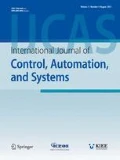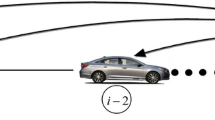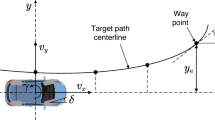Abstract
This paper presents a dual-mode distributed model predictive control (DMPC) strategy for platooning of connected vehicles with nonlinear dynamics. A third-order nonlinear model is employed to describe the dynamic characteristics of vehicles. In order to deal with the system nonlinearity and enhance the control precision, a DMPC based optimization problem is formulated for the vehicle platoon control, in which the nonlinear dynamics and the input boundaries are both considered as its constraints. Then, a dual-mode structure with the control scheme from the optimization and a local state feedback controller is proposed to drive the vehicles to the desired platoon. Comparing with other vehicle platoon algorithms, the proposed dual-mode DMPC strategy can significantly reduce the computational burden and save the communication resources. Furthermore, the iterative feasibility and the stability of proposed control system are strictly analyzed. In final, numerical simulations are provided to validate the effectiveness of proposed approaches.
Similar content being viewed by others
References
J. Zhang, F.-Y. Wang, K. Wang, W.-H. Lin, X. Xu, and C. Chen, “Data-driven intelligent transportation systems: A survey,” IEEE Transactions on Intelligent Transportation Systems, vol. 12, no. 4, pp. 1624–1639, 2011.
X. Liu and Y. Zou, “A kind of synergic control for a collection of vehicles,” International Journal of Control, Automation and Systems, vol. 10, no. 3, pp. 459–469, 2012.
M. Jerret, R. McConnell, J. Wolch, R. Chang, C. Lam, G. Dunton, F. Gilliland, F. Lurmann, T. Lslam, and K. Berhane, “Traffic-related air pollution and obesity formation in children: a longitudinal, multilevel analysis,” Environmental Health, vol. 13, no. 1, pp. 49, 2014.
S. Solyom and E. Coelingh, “Performance limitations in vehicle platoon control,” IEEE Intelligent Transportation Systems Magazine, vol. 5, no. 4, pp. 112–120, 2013.
M. Amoozadeh, H. Deng, C. N. Chuah, H. M. Zhang, and D. Ghosal, “Platoon management with cooperative adaptive cruise control enabled by VANET,” Vehicular Communications, vol. 2, no. 2, pp. 110–123, 2015.
H. Wen, J. Sun, and X. Zhang, “Study on traffic congestion patterns of large city in China taking Beijing as an example,” Procedia-Social and Behavioral Sciences, vol. 138, pp. 482–491, 2014.
Y. Zhang, T. Liu, Q. Bai, W. Shao, and Q. Wang, “New systems-based method to conduct analysis of road traffic accidents,” Transportation research part F: traffic psychology and behaviour, vol. 54, pp. 96–109, 2018.
S. E. Shladover, C. A. Desoer, J. K. Hedrick, M. Thomizuke, J. Walrand, W.-B. Zhang, D. H. McMahon, H. Peng, S. Sheikholeslam, and N. McKeown, “Automated vehicle control developments in the PATH program,” IEEE Transactions on Vehicular Technology, vol. 40, no. 1, pp. 114–130, 1991.
R. Kianfar, B. Augusto, A. Ebadighajari, U. Hakeem, J. Nilsson, A. Raza, R. S. Tabar, N. V. Irukulapati, C. Englund, P. Falcone, S. Papanastasiou, L. Svensson, and H. Wymeersch, “Design and experimental validation of a cooperative driving system in the grand cooperative driving challenge,” IEEE Transactions on Intelligent Transportation Systems, vol. 13, no. 3, pp. 994–1007, 2012.
T. Robinson, E. Chan, and E. Coelingh, “Operating platoons on public motorways: An introduction to the sartre platooning programme,” Proceedings of the 17th World Congress on Intelligent Transport Systems, vol. 1, pp. 1–12, 2010.
S. Tsugawa, S. Kato, and K. Aoki, “An automated truck platoon for energy saving,” Proceedings of the IEEE International Conference on Intelligent Robots and Systems, pp. 4109–4114, 2011.
C. S. Chin and C. Wheeler, “Sliding-mode control of an electromagnetic actuated conveyance system using contactless sensing,” IEEE Transactions on Industrial Electronics, vol. 60, no. 11, pp. 5315–5324, 2013.
M. Yan, Y. Tang, P. Yang, and L. Zuo, “Consensus based platoon algorithm for velocity-measurement-absent vehicles with actuator saturation,” Journal of Advanced Transportation, vol. 2017, pp. 1–8, 2017.
Q. Zhu, B. Dai, Z. Huang, Z. Sun, and D. Liu, “An adaptive longitudinal control method for autonomous follow driving based on neural dynamic programming and internal model structure,” International Journal of Advanced Robotic System, vol 14, no. 6, pp. 1–13, 2017.
R. Kianfar, P. Falcone, and J. Fredriksson, “A control matching model predictive control approach to string stable vehicle platooning,” Control Engineering Practice, vol. 45, pp. 163–173, 2015.
B. Li, H. Y. Yang, Z. Q. Chen, and Z. X. Liu, “Distributed containment control of multi-agent systems with general linear dynamics and time-delays,” International Journal of Control, Automation and Systems, pp. 1–9, 2018.
Y. Li, K. Li, T. Zheng, X. Hu, H. Feng, and Y. Li, “Evaluating the performance of vehicular platoon control under different network topologies of initial states,” Physica A: Statistical Mechanics and its Applications, vol. 450, pp. 359–368, 2016.
J.-W. Kwon and D. Chwa, “Adaptive bidirectional platoon control using a coupled sliding mode control method,” IEEE Transactions on Intelligent Transportation Systems, vol. 15, no. 5, pp. 2040–2048, 2014.
M. Yan, J. Song, L. Zuo, and P. Yang, “Neural adaptive sliding-mode control of a vehicle platoon using output feedback,” Energies, vol. 10, no. 11, pp. 1906, 2017.
W. B. Dunbar and R. M. Murray, “Distributed receding horizon control for multi-vehicle formation stabilization,” Automatica, vol. 42, no. 4, pp. 549–558, 2006.
H. Li, Y. Shi, and W. Yan, “Distributed receding horizon control of constrained nonlinear vehicle formations with guaranteed g -gain stability,” Automatica, vol. 68, pp. 148–154, 2016.
W. B. Dunbar and D. S. Caveney, “Distributed receding horizon control of vehicle platoons: Stability and string stability,” IEEE Transactions on Automatic Control, vol. 57, no. 3, pp. 620–633, 2012.
T. Keviczky, F. Borrelli, K. Fregene, D. Godbole, and G. Balas, “Decentralized receding horizon control and coordination of autonomous vehicle formations,” IEEE Transactions on Control Systems Technology, vol. 16, no. 1, pp. 19–33, 2008.
A. Maxin, C. F. Caruntu, and C. Lazar, “Distributed model predictive control algorithm for vehicle platooning,” Proceedings of the 20th International Conference on System Theory, Control and Computing, pp. 657–662, 2016.
H. A. Izadi, B. W. Gordon, and Y. Zhang, “Decentralized receding horizon control for cooperative multiple vehicles subject to communication delay,” Journal of Guidance, Control, and Dynamics, vol. 32, no. 6, pp. 1959–1965, 2009.
Y. Zhang, S. E. Li, K. Li, F. Borrelli, and J. K. Hedrick, “Distributed model predictive control for heterogeneous vehicle platoons under unidirectional topologies,” IEEE Transactions on Control Systems Technology, vol. 25, no. 3, pp. 899–910, 2017.
R. Wang, H. Jing, C. Hu, M. Chadli, and F. Yan, “Robust H ∞ output-feedback yaw control for in-wheel motor driven electric vehicles with differential steering,” Neurocomputing, vol. 173, pp. 676–684, 2016.
H. Dahmani, M. Chadli, A. Rabhi, and A. E. Hajjaji, “Road curvature estimation for vehicle lane departure detection using a robust Takagi-Sugeno fuzzy observer,” Vehicle System Dynamics, vol. 51, no. 5, pp. 581–599, 2013.
G. Wang, M. Chadli, H. Chen, and Z. Zhou, “Eventtriggered control for active vehicle suspension systems with network-induced delays,” Journal of the Franklin Institute, vol. 356, no. 1, pp. 147–172, 2019.
M. A. S. Kamal, M. Mukai, J. Murata, and T. Kawabe, “Model predictive control of vehicles on urban roads for improved fuel economy,” IEEE Transactions on Control Systems Technology, vol. 21, no. 3, pp. 831–841, 2013.
V. Turri, B. Besselink, and K. H. Johansson, “Cooperative look-ahead control for fuel-efficient and safe heavy-duty vehicle platooning,” IEEE Transactions on Control Systems Technology, vol. 25, no. 1, pp. 12–28, 2017.
D. Q. Mayne, J. B. Rawlings, C. V. Rao, and P. O. Scokaert, “Constrained model predictive control: Stability and optimality,” Automatica, vol. 36, no. 6, pp. 789–814, 2000.
W. B. Dunbar, “Distributed receding horizon control of dynamically coupled nonlinear systems,” IEEE Transactions on Automatic Control, vol. 52, no. 7, pp. 1249–1263, 2007.
S. Bououden, M. Chadli, and H. R. Karimi, “A robust predictive control design for nonlinear active suspension systems,” Asian Journal of Control, vol. 18, no. 1, pp. 122–132, 2016.
S. Bououden, M. Chadli, L. Zhang, and T. Yang, “Constrained model predictive control for time-varying delay systems: Application to an active car suspension,” International Journal of Control, Automation and Systems, vol. 14, no. 1, pp. 51–58, 2016.
Author information
Authors and Affiliations
Corresponding author
Additional information
Publisher’s Note Springer Nature remains neutral with regard to jurisdictional claims in published maps and institutional affiliations.
Recommended by Associate Editor Andrea Cristofaro under the direction of Editor Myo Taeg Lim. This work was supported by the National Natural Science Foundation of China (No. 61803040), the Science Research Plan in Shaanxi Province of China (Nos. 2018JQ6098, 2019GY-218) and the Fundamental Research Funds for the Central University of China (Nos. 300102328403, 300102328303).
Maode Yan received his B.S., M.S. and Ph.D. degrees in School of Marine Science and Technology, Northwestern Polytechnical University, Xi’an, China, in 1996, 1999, and 2001, respectively. He is currently a Professor with the School of Electronic and Control Engineering, Chang’an University, Xi’an, China. His research interests are networked control systems, vehicle platoon modeling and control, robots and their formation control, embedded systems and Applications.
Wenrui Ma received his B.S. degree from Chang’an University in 2017. He is currently a graduated student in Electronic and Control Engineering, Chang’an University, Xi’an, China. His current research interests are model predictive control, formation control and intelligent system.
Lei Zuo received his B.Sc. and Ph.D. degrees form Northwestern Polytechnical University (NWPU), in 2011 and 2017, respectively. Since June 2017, he has been with the school of Electronic and Control Engineering, Chang’an University, Xi’an, where he is currently an Assistant Professor. His current research interests include multi-agent systems, coverage control, model predictive control and vehicle platoon control.
Panpan Yang received his Ph.D. from Northwestern Polytechnical University, Xi’an, China, in 2016. He is currently a lecturer in the School of Electronic and Control Engineering, Chang’an University, Xi’an, China. His main research interests include control and application of mobile robots, modeling, control and analysis of flocking system, cooperative control of autonomous vehicles.
Rights and permissions
About this article
Cite this article
Yan, M., Ma, W., Zuo, L. et al. Dual-mode Distributed Model Predictive Control for Platooning of Connected Vehicles with Nonlinear Dynamics. Int. J. Control Autom. Syst. 17, 3091–3101 (2019). https://doi.org/10.1007/s12555-018-0828-9
Received:
Revised:
Accepted:
Published:
Issue Date:
DOI: https://doi.org/10.1007/s12555-018-0828-9




